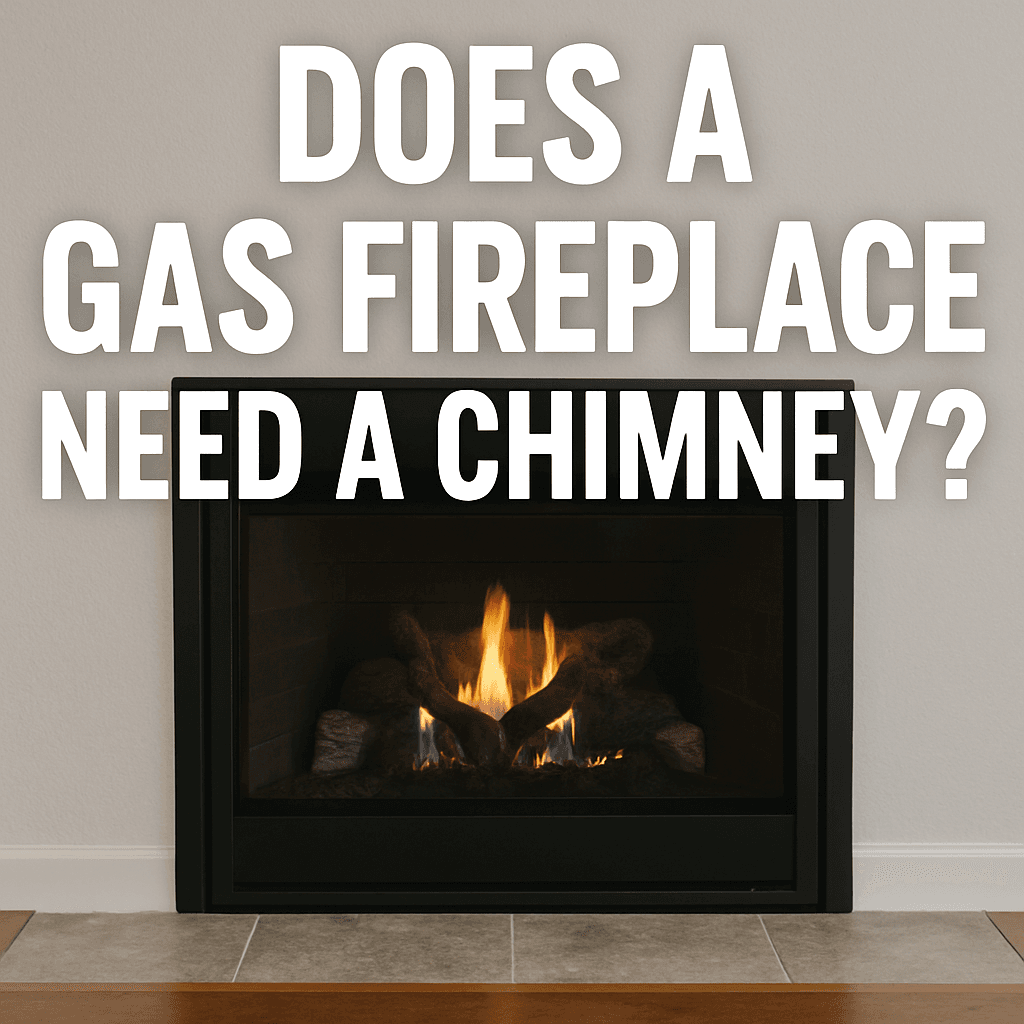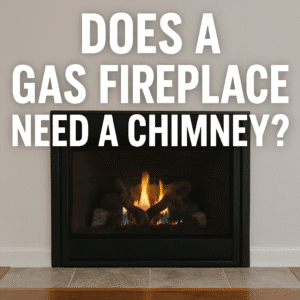Does a Gas Fireplace Need a Chimney? The Definitive 2025 Expert Answer
There’s nothing quite like the warm, flickering glow of a fireplace on a cool evening. But the thought of chopping wood, dealing with soot, and yearly chimney sweeps can be a major deterrent. This is where the modern convenience of a gas fireplace shines—instant ambiance at the flick of a switch. But this convenience leads to one of the most common questions we hear from homeowners: **”Do I still need a chimney for a gas fireplace?”**
The simple, and perhaps surprising, answer is: **It depends entirely on the type of gas fireplace you choose.** Unlike their wood-burning ancestors, not all gas fireplaces require that traditional brick-and-mortar structure rising from your roof. Modern venting technology has opened up a world of possibilities, allowing you to install a fireplace in rooms and homes where it was once impossible.
As a certified fireplace technician with over a decade of experience, I’m here to clear the air (pun intended). We’ll break down the different types of gas fireplaces, explain exactly how each one vents, and help you understand the critical safety considerations. By the end of this guide, you’ll know precisely which option is right for your home, ensuring a safe, efficient, and beautiful hearth for years to come.

The Short Answer: A Quick Guide to Gas Fireplace Venting
- Direct Vent Fireplaces: No traditional chimney needed. They use a special co-axial pipe that vents directly outside through a wall or roof.
- B-Vent (Natural Vent) Fireplaces: Yes, they need a chimney or a specific type of metal vent pipe running through the roof.
- Vent-Free (Ventless) Fireplaces: No chimney or vent needed. They exhaust a small amount of fumes directly into the room and come with major safety considerations.
Understanding the “Big Three”: Types of Gas Fireplaces Explained
To truly grasp the chimney question, you need to understand how each type of gas fireplace works. Let’s explore the mechanics, pros, and cons of the three main players on the market.
1. Direct Vent Gas Fireplaces (The Modern Standard)
Direct vent units are the most popular and widely recommended type of gas fireplace in the U.S. today, and for good reason. They are engineered for safety and efficiency.
How They Work:
A direct vent fireplace is a completely sealed unit with a glass front that does not come off. It draws all the air it needs for combustion from outside the home through a clever dual-chamber pipe (a pipe within a pipe). The inner pipe expels the exhaust fumes (like carbon monoxide and water vapor), while the outer pipe draws in fresh oxygen. Because it’s a closed system, it doesn’t affect your indoor air quality or oxygen levels.
Do They Need a Chimney?
No. They do not need a traditional masonry chimney. The special vent pipe can be run vertically through the roof or, more commonly, horizontally through an exterior wall. This flexibility is their biggest selling point—you can install a direct vent fireplace almost anywhere. When routing a vent through the roof, it’s just another roof penetration, similar to plumbing stacks or securing the best chimney antenna mount for your home entertainment system.
- Pros: High efficiency (70-85%), excellent safety record, flexible installation, no drafts, improves indoor air quality by not using indoor air.
- Cons: Can be more expensive to purchase and install, requires placement near an exterior wall or roof access.
2. B-Vent (Natural Vent) Gas Fireplaces (The Traditionalist)
B-Vent units, also known as natural vent fireplaces, operate more like a traditional wood-burning fireplace. They are often found in the form of “gas log sets” designed to be installed inside an existing masonry chimney.
How They Work:
A B-Vent fireplace draws combustion air from inside your home. As the fuel burns, the hot exhaust gases, which are lighter than the surrounding air, naturally rise and exit your home through a vertical vent pipe or an existing chimney. It’s simple physics, but it comes with some drawbacks.
Do They Need a Chimney?
Yes, absolutely. This type of fireplace must have a vertical vent. It can be a dedicated, double-walled B-vent pipe that runs through your roof, or it can be routed through a pre-existing, fully functional, and properly lined wood-burning chimney. If you use an existing chimney, it must be in excellent condition. This is where regular maintenance is key; you need to ensure the structure is sound, using the best mortar for chimney repairs and knowing if your homeowners insurance covers chimney repair in case of major issues.
Even with a gas insert, an uncapped chimney is an open invitation for wildlife. Dealing with how to get a raccoon out of your chimney is a problem you want to avoid at all costs by installing a proper cap.
- Pros: Often less expensive than direct vent units, can produce a very realistic, tall, dancing flame.
- Cons: Lower efficiency (much of the heat escapes up the flue), uses pre-heated oxygen from your room, creates a potential path for drafts.
3. Vent-Free (Ventless) Gas Fireplaces (The Controversial Choice)
Vent-free fireplaces are, as the name implies, ventless. They don’t require any chimney, flue, or pipe to the outdoors. This makes them incredibly easy to install, but they come with significant debate and safety warnings.
How They Work:
These units are designed to burn natural gas or propane with extremely high efficiency (up to 99.9%). Because the combustion is so complete, they produce very low levels of exhaust, which are vented directly into the room. They are required by law to have an Oxygen Depletion Sensor (ODS) that automatically shuts the unit off if oxygen levels in the room drop to an unsafe point.
Do They Need a Chimney?
No. They require no venting of any kind, which is why they appeal to some. But this convenience comes at a cost. The small amounts of carbon monoxide, nitrogen dioxide, and water vapor they produce are all released inside your home. This is why vent-free appliances are **banned in California, Massachusetts, and several other states and municipalities.** Many fireplace professionals refuse to install them due to safety concerns.
- Pros: Highest energy efficiency, low installation cost, can be installed almost anywhere.
- Cons: Significant health and safety concerns, banned in many areas, releases moisture into the home, can deplete oxygen.
Essential Safety Gear for Every Gas Fireplace Owner
Regardless of which type of fireplace you choose, safety is paramount. The single most important device you can own is a carbon monoxide detector. Since CO is colorless and odorless, it’s the only way to be alerted to a potential leak or malfunction.

Non-Negotiable Safety: Kidde Carbon Monoxide Detector
This is not an accessory; it’s a necessity. This plug-in detector with a battery backup provides continuous monitoring for carbon monoxide. Place one on every level of your home, especially near sleeping areas and rooms with fuel-burning appliances.
Check Price on AmazonConverting a Wood-Burning Fireplace to Gas
Have an old, drafty wood fireplace you never use? Converting it to a gas insert is one of the best home improvement projects you can do. It eliminates drafts, provides efficient heat, and gives you a beautiful fire with zero effort.
The process typically involves:
- Thorough Inspection and Cleaning: A certified chimney sweep must inspect the entire structure for safety. Then, years of creosote and soot must be removed. This is a job for the best chimney sweep vacuum with powerful suction and advanced filtration to prevent a mess in your home.
- Running a Gas Line: A licensed plumber or gas fitter will run a gas line to the firebox.
- Installing the Insert and Liner: A direct vent or B-vent insert is fitted into the opening, and a new, properly sized flexible liner is run up the length of the old chimney flue to ensure proper venting.
Frequently Asked Questions (FAQ)
Can I install a TV above a gas fireplace?
Yes, this is a very popular design choice, but it must be done correctly. You need to ensure the wall is properly insulated and that the fireplace manufacturer’s clearance requirements are strictly followed to prevent heat damage to your television. Some modern fireplaces have “cool wall” technology specifically for this purpose.
How much does it cost to install a gas fireplace without a chimney?
The cost for a new direct vent gas fireplace installation typically ranges from $4,000 to $8,000 in 2025, including the unit, venting, and labor. Costs vary widely based on the model, complexity of the installation, and your location.
Do I need electricity for a gas fireplace to work?
Most modern gas fireplaces use a battery-powered electronic ignition system or have a standing pilot light, so they will still light and produce heat during a power outage. However, any features like remote controls or built-in fans will not work without electricity.
Can animals get into my fireplace vents?
It’s a valid concern. For B-vents using a traditional chimney, a proper cap is essential to keep animals out. Direct vent terminations on the side of a house are designed to prevent animal entry, but it’s wise to check them periodically for nests. It’s far less of an issue than an open flue, where you might ask how long for a bird stuck in a chimney to die, but diligence is always smart.
Conclusion: The Future of Fireplaces is Flexible
So, does a gas fireplace need a chimney? As you now know, the answer is a resounding “no” for the most popular and modern types. Thanks to direct vent technology, the warmth and beauty of a fireplace are no longer limited to homes with existing masonry structures. You have the freedom to add a stunning focal point to almost any room in your house.
The key is to prioritize safety and performance by choosing a vented system, whether it’s a direct vent unit or a B-vent insert for your existing hearth. Always trust the installation to a certified professional, and never, ever operate any fuel-burning appliance without a working carbon monoxide detector nearby. By making informed choices, you can enjoy decades of cozy, convenient, and safe fireside memories—no chimney sweeping required, and no need for Santa to find an alternate route, though there are always fun theories on how Santa gets in without a chimney!

